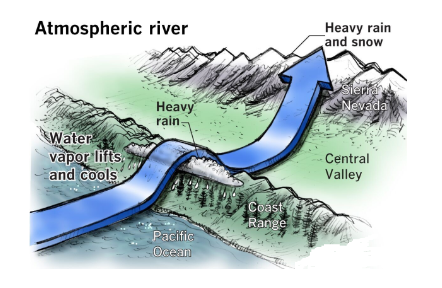12 Nov 2024 14:29:32 pm
Geography
Atmospheric Rivers
Tags :
Atmospheric Rivers

Topic: Physical Geography
Why in the news?
- According to a new study published in Science Advances, University of California, atmospheric rivers have shifted about 6 to 10 degrees toward the two poles over the past four decades and that’s changing weather patterns around the world.
- The shift is worsening droughts in some regions, intensifying flooding in others, and putting water resources that many communities rely on at risk. When atmospheric rivers reach far northward into the Arctic, they can also melt sea ice, affecting the global climate.
Source: Down To Earth
About Atmospheric Rivers:
- These are long, concentrated regions in the atmosphere that transport moist air from the tropics to higher latitudes.
- They are responsible for 90 percent of the movement of moisture from the tropics toward the poles.
- They are the largest transport mechanisms of freshwater on Earth.
- They form when large-scale weather patterns align to create narrow channels, or filaments, of intense moisture transport.
- Ten or more atmospheric rivers can be happening at once across the globe.
- A well-known and strong one is the Pineapple Express, with moisture transported from the tropical Pacific around Hawaii to the US and Canadian West Coasts.
- Typically,250 to 375 miles wide, atmospheric rivers can stretch more than a thousand miles long.
- They are more frequent on the East Coast than they are on the West Coast.
- They primarily occur during the winter of the respective hemisphere, when extratropical cyclones are most prevalent.
- The average atmospheric river carries an amount of water vapor roughly equivalent to the average flow of water at the mouth of the Mississippi River (second-longest river in North America).
- When atmospheric rivers run up against mountains or run into local atmospheric dynamics and are forced to ascend, the moisture they carry cools and condenses, so they can produce intense rainfall or snowfall.
- While they are an incredibly important source of rainfall, they can also bring flash flooding, mudslides, and landslides, sometimes killing people and destroying property.
- When atmospheric rivers pass over land, they can cause conditions similar to those of hurricanes with intense and rapid rainfall, cyclone-force winds, and significantly increased wave heights.

